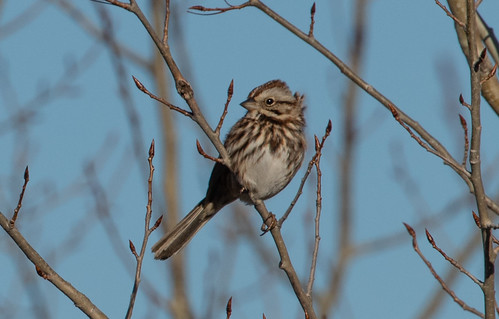 |
| Song Sparrow |
Our looks at those Common Mergansers were very brief but excellent as a learning opportunity. Common Mergansers are very often mistaken for loons while swimming or flying, and today we got clear looks of them doing both. As if wanting to help cement the lessons, one helpful loon flew past and another swam in the bay for us. Everyone got to see how the long, low-slung silhouettes in the water are quite similar, but that the mergansers have all while sides and a narrower, bright red bill; the checkered back on a swimming loon extends down the sides, and the bill is sturdier and all black. In flight, the loon's front and back ends seem more evenly balanced—the merganser's feet don't extend behind as far. When you can see above, the merganser has white patches on the wings that the loon lacks. And the loon's wingbeats aren't anywhere near as rapid. When our mergansers dropped down into the water, they banked in perfect light for everyone to see their bright orange feet. That happened too fast to get photos.
 |
| Common Mergansers in flight. Notice that the head and neck jut out forward further than the legs and feet do behind, and that the feet are orange. |
 |
| This crappy photo of a loon in flight was not taken today. Notice how much further the legs and feet extend. (Also notice that the legs and feet are black.) |
 |
| Common Loon. Notice the black, sturdy bill and the checkered back and sides. |
Despite being in the open, the surrounding vegetation must have effectively blocked the wind close to the ground, because the gulls faced every which way. A young Bald Eagle flew in, causing pandemonium for the gulls, but it just alighted on the ground to give us fine views before it took off again.
 |
| Young Bald Eagle |
Another young Bald Eagle alighted at the top of a spruce tree and gave us several minutes of confusion. I was pretty sure it was an eagle from the start because of its scruffy plumage and the fact that the bill seemed oversized for a hawk, but the apparent sizes of birds can be extremely misleading, and this one not only looked as small as a Red-tailed Hawk; it also managed to hold onto a pretty slim branch, so we spent a lot of time trying to decide which hawk it was until we finally decided that it really was an eagle. Even so, I studied the photos when I got home to verify the decision. It appears to be a second-year Bald Eagle.
 |
| Young Bald Eagle |
I like to start our warbler walks in early April, despite the low number of species. This is a great time to learn a few songs well, and everywhere along our walk at least one Song Sparrow was singing away, helping people key in on how it starts with two or three identical notes and then breaks into a jumble. Song Sparrows in different areas of the country, and even in different areas of a city, sing different dialects. But all the songs start with two or three identical notes before breaking into something else.
 |
| Song Sparrow |
One of our most interesting sightings was of two birds that are both too common and cause problems for other species. A Brown-headed Cowbird and a European Starling sat side-by-side on the top of a spruce, and we could closely observe their differences: the long, narrow, yellow bill of the starling vs. the shorter, stouter, dark bill of the cowbird; the all-black, sleek body plumage of the cowbird vs. the somewhat flecked body plumage of the starling; and the starling's short, broad tail with chevrons where it meets the body vs. the longer, narrower, all-black tail of the cowbird.
 |
| European Starling (left) and Brown-headed Cowbird |
As the weeks progress and we get more species, we won't devote as much time to the common ones as we could today.
I'll keep posting recaps and photos of the birds we see on these warbler walks my blog, where I also have information about how to join us on these free little activities, which have become such a treasured tradition of Duluth Audubon Society.
15 species
- Canada Goose (Branta canadensis) 10
- Common Merganser (Mergus merganser) 5
- Common Loon (Gavia immer) 2
- Bald Eagle (Haliaeetus leucocephalus) 2
- Ring-billed Gull (Larus delawarensis) 150
- Herring Gull (Larus argentatus) 5
- American Crow (Corvus brachyrhynchos) 30
- Common Raven (Corvus corax) 1
- Black-capped Chickadee (Poecile atricapillus) 15
- American Robin (Turdus migratorius) 4
- European Starling (Sturnus vulgaris) 6
- Song Sparrow (Melospiza melodia) 10
- Red-winged Blackbird (Agelaius phoeniceus) 10
- Common Grackle (Quiscalus quiscula) 30
- Brown-headed Cowbird (Molothrus ater) 1


